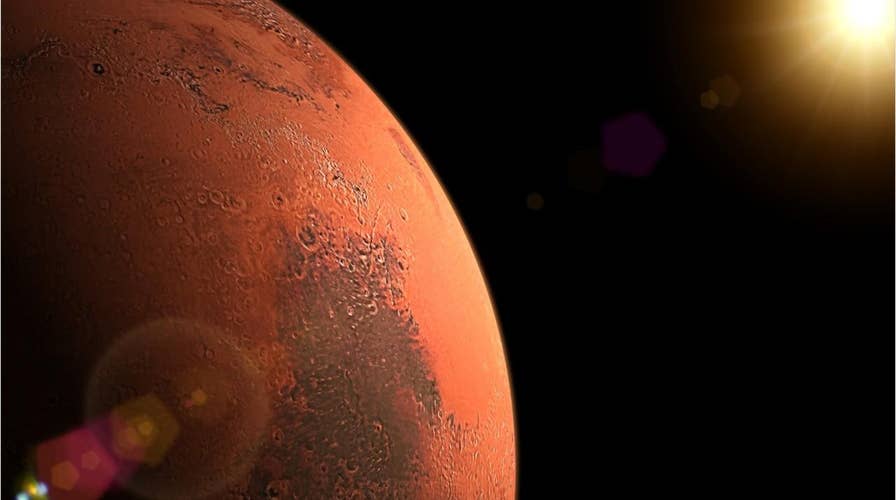University professor believes he’s found insect-like life forms on Mars
After looking at photos taken by various Mars rovers over several years, Ohio University emeritus professor William Romoser has found a number of 'insect-like forms, structured similarly to bees, as well as reptile-like forms,' according to a release from the university. Romoser made the claim at the annual Entomological Society of America meeting.
NASA has vehemently denied that there are living "insect- and reptile-like creatures" on Mars, after a professor at Ohio University made the controversial claim earlier this week.
"The collective general opinion of the large majority of the scientific community is that current conditions on the surface of Mars are not suitable for liquid water or complex life," Alana Johnson, NASA's Public Affairs Officer, said in a statement to Fox News.
Johnson added that one of NASA's objectives is "the search for life in the universe" and with the upcoming Mars 2020 rover, the government space agency hopes to take the next steps "in exploring the potential of past life on the Red Planet."
'THERE HAS BEEN AND STILL IS LIFE ON MARS,' EXPERT CLAIMS, CITING NASA PHOTOS
"Although we have yet to find signs of extraterrestrial life, NASA is exploring the solar system and beyond to help us answer fundamental questions, including whether we are alone in the universe," Johnson continued. "From studying water on Mars, probing promising 'oceans worlds,' such as Enceladus, Europa, and Titan to looking for biosignatures in the atmospheres of planets outside our solar system, NASA’s science missions are working together with a goal to find unmistakable signs of life beyond Earth."
NASA gave a similar statement after a former NASA scientist, Gilbert Levin, who worked on the Viking missions to the Red Planet during the 1970s, published a stunning op-ed last month that said he is convinced that the space agency "found evidence of life" on Mars.
Ohio University emeritus professor William Romoser, who spent the past several years looking at a number of photos publicly available from various Mars rovers, including the Curiosity rover, made the controversial claim he had spotted a number of "insect-like forms, structured similarly to bees, as well as reptile-like forms."
“There has been and still is life on Mars,” Romoser, who specializes in arbovirology and general/medical entomology, said in a statement from the university published on Tuesday. “There is apparent diversity among the Martian insect-like fauna which display many features similar to Terran insects that are interpreted as advanced groups — for example, the presence of wings, wing flexion, agile gliding/flight, and variously structured leg elements.”
Romoser also specifically mentioned the Curiosity rover, which has been exploring the Gale Crater since landing on Mars in August 2012. Curiosity has made some incredible discoveries, including a surprising spike in the level of methane, oxygen behaving "in a way that so far scientists cannot explain," a mysterious, unexplained white light and many others.
The claims from Romoser drew ire from some in the scientific community, including other entomologists.
NASA: ANCIENT MARS OASIS COULD HAVE SUPPORT LIFE
"I am a bit skeptical," Pepperdine University visiting professor and entomologist Susan Finkbeiner said in an email to Fox News. "If these are 'current' living forms, we would need to see more evidence that life can be sustained. Where are the resources for these arthropods? What are they eating, and are they reproducing?"
Finkbeiner, who was not involved in examining the photos, added that if anything, the objects that Romoser claims are alive may be fossils.
"Even though early insects on Earth had wings, the atmosphere on our planet was thicker to allow flight and I am not convinced the thin atmosphere on Mars would allow for successful flight, but that is something an insect physiologist or biomechanics specialist would need to be consulted for," Finkbeiner added. "If these observed images are actually of arthropod-like creatures, I’m more inclined to think they are not currently extant and are probably fossils of extinct creatures."
Mars' atmosphere is comprised of 95 percent carbon dioxide, 2.6 percent molecular nitrogen, 1.9 percent argon, 0.16 percent oxygen and 0.06 percent carbon monoxide. For comparison purposes, Earth's atmosphere is 78 percent nitrogen, 21 percent oxygen, 0.9 percent argon, and 0.03 percent carbon dioxide and trace amounts of other elements.
NASA's upcoming Mars 2020 rover, slated to land Feb. 18, 2021, will look for signs of fossilized evidence of extraterrestrial beings when it explores the Red Planet's Jezero Crater.





















